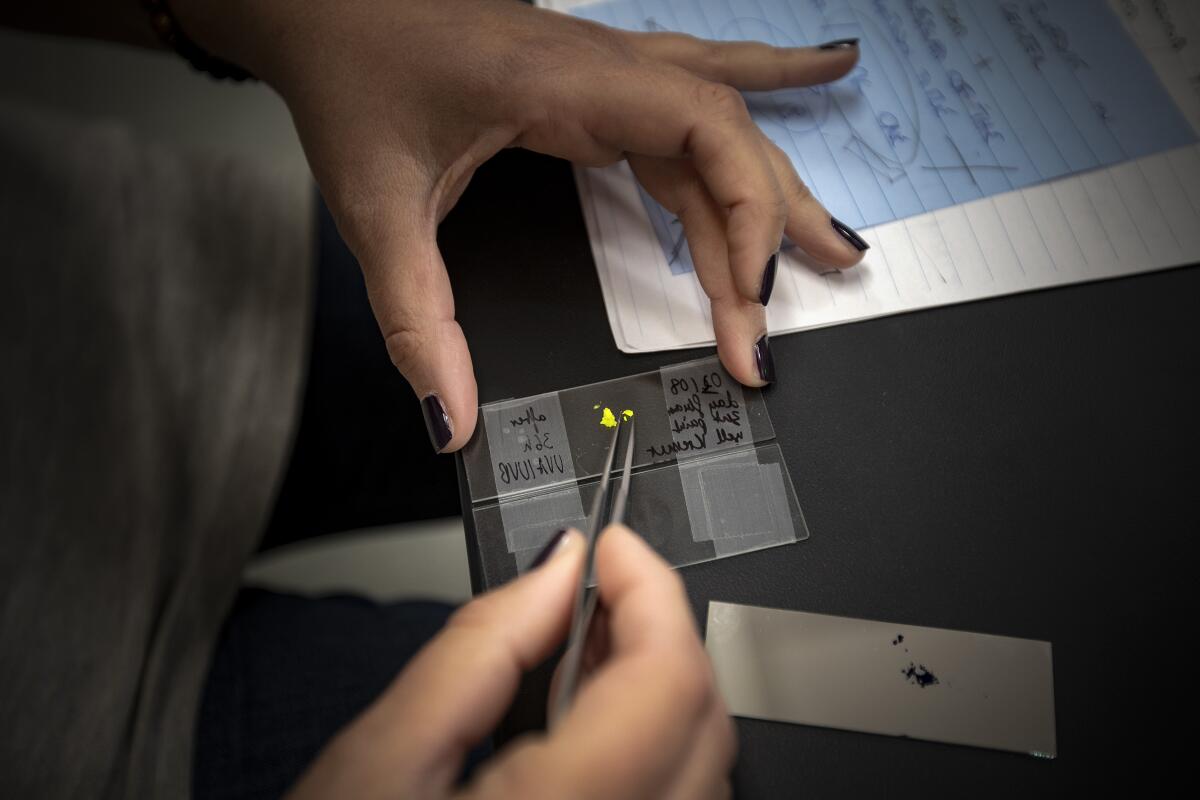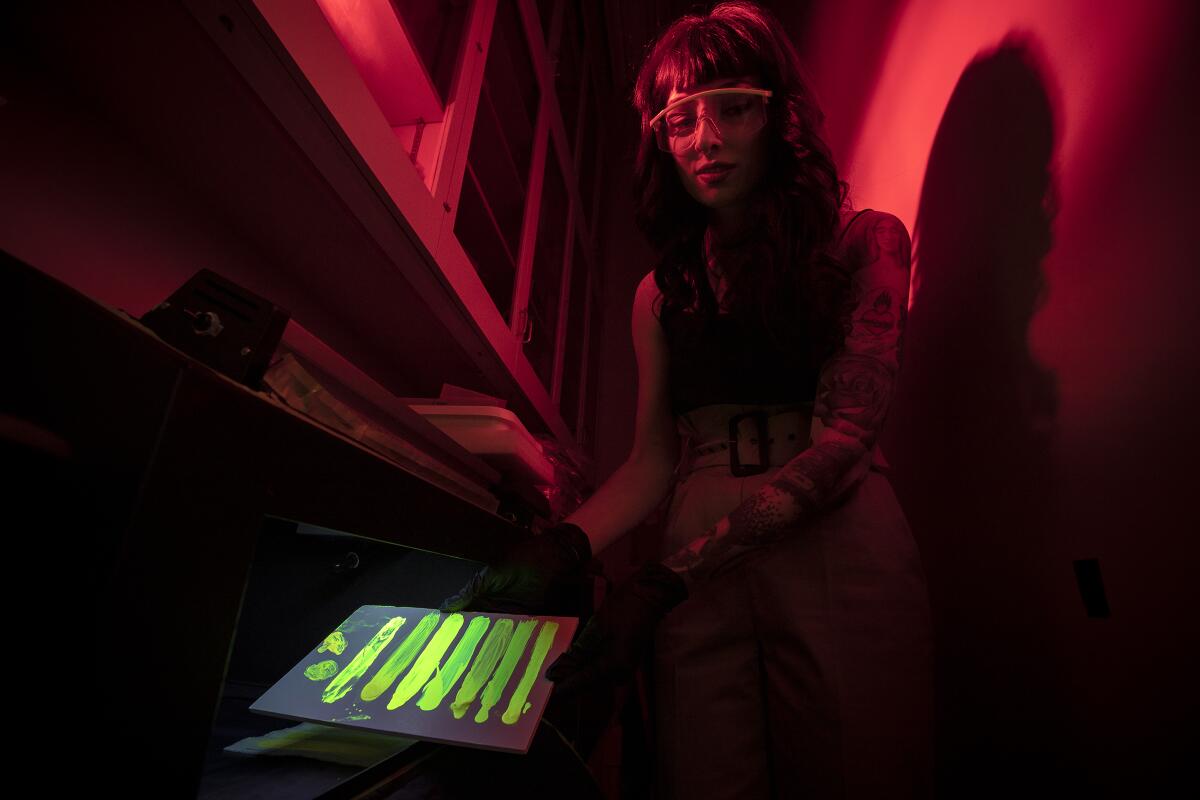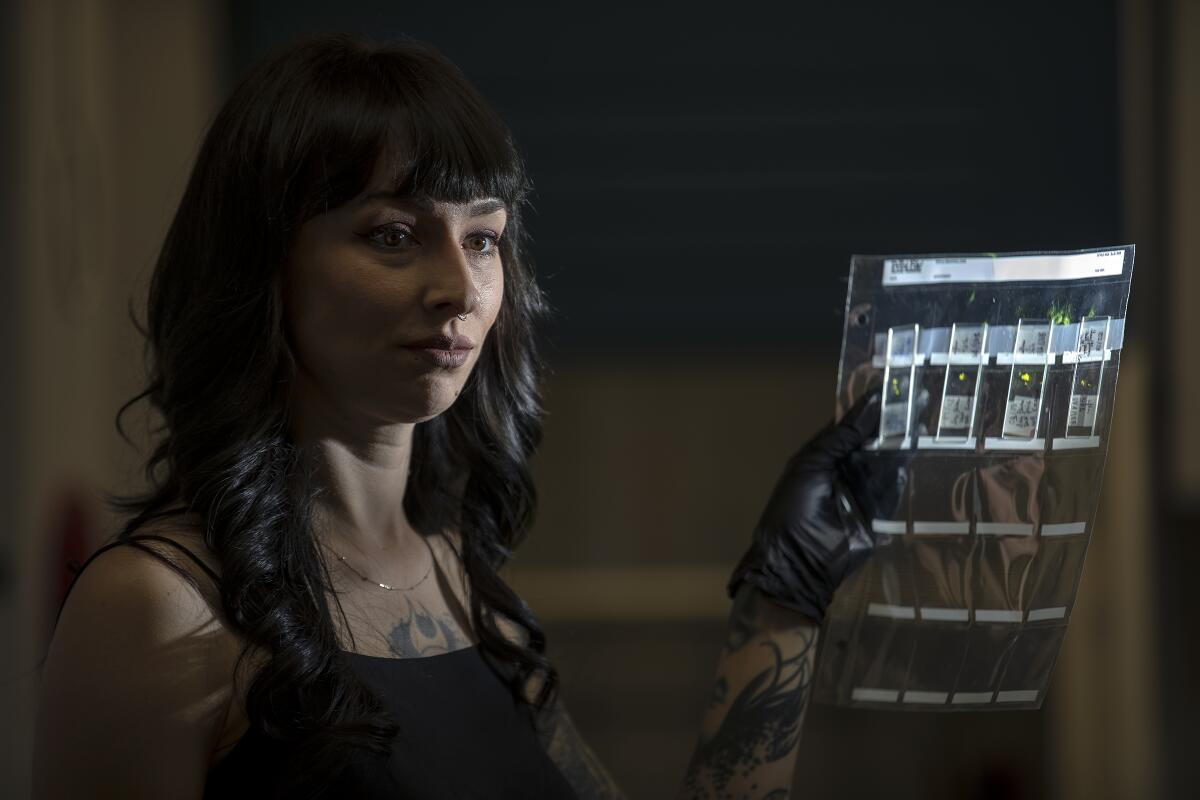Day-Glo masterpieces are fading. A conservator and her team are racing to save them

Deep in a basement laboratory at the Los Angeles County Museum of Art, conservator Kamila Korbela peered at the moon-cratered image on the screen of her microscope, searching.
It was a speckle of paint that outwardly appeared no different from a half-dozen others in her portfolio. But the museumâs sophisticated laser microscope told a different story.
For the record:
1:14 p.m. Sept. 11, 2019This article refers incorrectly to a piece of equipment at the Getty Conservation Institute. It is a gas chromatograph mass spectrometer, not a gas chromatic mass spectrometer.
9:08 a.m. Sept. 5, 2019An earlier version of this article said Day-Glo Color Corp. is based in Dayton, Ohio. The company is based in Cleveland.
Instead of magnifying the sample, it measured the vibration of its chemical elements. The readings showed that this fleck of color was unlike the others.
For the crusading conservator, this was a clue to unraveling an urgent mystery that is as much about art as it is physics and chemistry.
Korbela is trying to save âBampur,â a migrainous color-block behemoth painted in 1965 by the influential modern artist Frank Stella â on view for the first time since 1980 in a LACMA retrospective. Like her paint speckle, it vibrates. At least, it used to.
âThe yellow has definitely faded at a faster rate than the pink or the blue,â which are still so unnaturally bright that Korbela could work on them for only a few minutes at a time before getting a headache.
âYellow is particularly difficult,â she said. âYou canât replicate it unless you replicate the constituent dyes. And itâs all secret.â
This secret is called Saturn Yellow.
It is the trademarked name of a fluorescent chartreuse â think caution tape or a high-voltage sign â that conservators say is among the most photochemically complex paints ever made by the Day-Glo Color Corp. of Cleveland.

Day-Glo still makes Saturn Yellow, although conservators say the modern formula is significantly different from the one used by trailblazing modern artists in the 1950s and â60s.
Korbela said she hoped to get the companyâs help in restoring the work â to secure a copy of the formula, or samples of dry pigment for conservators to test â but after months of trying unsuccessfully to reach them, she gave up.
But it didnât quash her ambition. Rather, it set in motion a laborious effort to reverse engineer the hueâs midcentury formulation, and her nearly two-year quest has drawn interest from prominent figures in art conservation.
âItâs not just to treat this one painting that happens to belong to LACMA. ⌠I think the outcomes will be a lot more significant,â said Margaret Holben Ellis, chair of the Conservation Institute at the New York University Institute of Fine Arts. âThereâs a lot of Day-Glo out there. Itâs in every kind of artwork imaginable.â
Column One
Column One is a showcase for compelling storytelling from Los Angeles Times.
The company said its current paints work well for restoration purposes but that it would not divulge proprietary information. Tom DiPietro, Day-Gloâs vice president of research, put it this way: âItâd be like giving you the formula for Coke.â
But after The Times described the LACMA teamâs efforts, the company agreed to provide Korbelaâs team with pigment samples and a data sheet with some limited details about their composition.
The future of some well-known works of modern art could hang on Korbelaâs research, experts said. If the Day-Glo shades canât be replicated, many fear that renowned works such as âF-111,â James Rosenquistâs 86-foot long protest piece, and Andy Warholâs âFlowersâ could literally disappear.
âThese paintings contain a glowing ghost that cannot be captured on a photograph,â said Stefanie De Winter, a Belgium-based conservator who is an expert on fluorescent art. âI think that if we wait for another 50 years, they will be milky-colored ruins, which will have lost their original effect and meaning.â
As novelist and merry prankster Ken Kesey told the Daily Telegraph in 1999: âNothing looks worse than faded-out DayGlo.â
Nothing.
::
Youâve seen the work of the Day-Glo Color Corp. even if you donât know youâve seen it. The companyâs shades are a packaging staple, the secret sauce that gives a Tide box its sparkle. Its pigments have long been popular in public art, from murals in Miami to the protest graffiti painted on the Berlin Wall.
What makes the companyâs colors so revolutionary is that they radiate in sunlight, while ordinary âneonâ pigments glow only with black lights in the dark. This atomic innovation is what drew artists and industrial designers to the medium. Day-Glo paints are intrinsically technical, a truly Space-Age material.
Nothing like this exists in nature â these are man-made colors.
— Margaret Holben Ellis, chair of the Conservation Institute at the NYU Institute of Fine Arts.
âNothing like this exists in nature â these are man-made colors,â said Ellis, who is president of the American Institute for Conservation, a nonprofit based in Washington. âThey look very alien, and thatâs one reason Frank Stella liked them.â
More often than not, the colors are used as highlights, but the 9-foot-tall âBampurâ is 100% fluorescent paint. Viewing it for more than a minute is ocular agony, the visual equivalent of an overdose.

âWhen I started out with âBampurâ [a colleague] was giving me different gray cards to rest my eyes on,â Korbela said. At times, she said, examining the painting at 10-times magnification was unbearable.
The pain of looking at âBampurâ is a function of photo-physics â electron-level exchanges of energy that convert invisible energy to visible light, creating colors so vibrant they scream.
âItâs literally electrons jumping from high to low energy levels,â Korbela said. Thatâs how all colors work â itâs just that the electrons in fluorescent pigments have more skips in their step.
This subatomic dance is what gives fluorescents their astral glow. They shimmer on the horizon of visible light, close to the limit of the human eye and far beyond where most cameras can see.
âYouâre seeing something that cannot be captured, and you donât know why it looks the way it looks, but you know it looks different,â Ellis said. âYour eye is seeing something that you donât understand. Thatâs why theyâre so effective.â
::
Day-Gloâs original paints were formulated in Berkeley in the 1930s, and were widely used by the American military in World War II on aircraft and in uniforms. Its pigments are up to four times brighter than traditional shades, and can be seen faster and from farther away.
In postwar America, Day-Glo quickly transitioned from the military to the counterculture, and through culture to art.
âIn the mid- to late 1950s, Stella turned away from oil paints and started using mediums like acrylic, enamel, epoxy paints and also fluorescents,â said Katia Zavistovski, who curated the LACMA exhibit. âThereâs still little understanding of how that fluorescent paint changes over time.â
Whatâs long been understood is this: The old shades of Day-Glo fade quickly. Pop artist Keith Haring was so distressed by this phenomenon that in the early 1980s he painted over a Day-Glo mural heâd finished just months earlier.
The â60s-era chartreuse is particularly delicate, conservators say. But what makes Korbelaâs quest especially urgent is a fungal infestation in âBampurâsâ canvas, one she has since identified in several other Stella works.
âWe wanted to in-paint the little fungal specklesâ to disguise the pattern made by the mold, Korbela said. Little did she know how difficult that would prove to be.
The first problem is that Saturn Yellow is a mix of both conventional color and fluorescent dye. Both types of pigment lose their brightness, but in different ways. While color fades, fluorescence is more correctly said to âextinguishâ â its ability to transform invisible energy to visible light exhausted through prolonged exposure.

Finding a color match for each of these complex components is a critical step in the process of developing a usable paint. But itâs just the first step.
âWhen you want to retouch the painting, you must artificially age the pigment,â De Winter said.
Recent fluorescent pigments have a reformulated composition and donât extinguish as quickly as the older ones, âwhich makes it impossible to match them with the old paint layer,â she added.
So Korbela spent months degrading samples of fluorescent paints that are currently on the market â a process she will begin anew with the dry pigments the company recently agreed to supply.
âI basically started to artificially age them,â she said, using the same bands of ultraviolet radiation that give you a sunburn.
The UV chamber in LACMAâs basement laboratory looks like a large toaster oven, and functions much like the light machines used to harden gel polish at nail salons.
The next step will be to tease the chemical mystery of Saturn Yellow from the polyvinyl alcohol primer that lies beneath it, a process so complicated the team can attempt it only with help from the wider Los Angeles art world.

Korbela will take tiny yellow samples â dribbles collected from the edge of the âBampurâ canvas â to the lab at the Getty Conservation Institute. There they will be tested using a gas chromatic mass spectrometer â a machine that more commonly looks at chemical weapons and stardust. The next stop will be UCLA, where the samples can be analyzed using an electron microscope and other sophisticated devices to produce images at the subatomic level.
âItâs very, very rare that there is the funding for that,â Korbela said of her science. âThatâs so cutting-edge itâs only happening at a couple of institutions.â
When she began chasing Saturn Yellow, Korbela still worked full time at LACMA, splitting her days between Stellaâs pieces and works by Yayoi Kusama, Joan Mitchell, John Singer Sargent, Rufino Tamayo and Pablo Picasso.
Now, she runs her own conservation company, LA Art Labs, and must wait for grants and squeeze tests in on the side â a process that will probably take months.
Even after all of that, the hunt for vintage Saturn Yellow might not be over.
âWe will have to do more analysis to find those perfect matches,â Korbela said. âItâs a field thatâs very much still in its baby shoes.â

The team plans to apply for a National Leadership Grant from the Institute of Museum and Library Services, which seeks projects that âaddress critical needs of the museum field.â But once they crack âBampurâsâ chemical genome, âwe will have a lock-and-key principle solution for thousands of paintings,â the conservator said.
Still, actually applying it to Stellaâs painting presents another challenge.
The perfect mixture, if it can be achieved, would then have to be applied to the painting with a brush made from just one or two hairs.
âIf itâs too dense a layer, [the paint particles] will cast shadows on each other, and appear darker,â Korbela said.
All of which raises the question: Why labor for years to preserve an effect that is fundamentally unpleasant? Couldnât viewers still appreciate âBampurâ if it didnât hurt when they looked?
âAbsolutely not,â said De Winter, the Day-Glo scholar. âWhen you cancel out the Day-Glo of the paintings you would lose the self-referential quality, the often-disturbing eye-catching effect,â and other elements the artist considered integral to his work.
Ellis was even more pointed.
âThereâs many works of art done in Day-Glo hanging in our museums that no longer glow,â the expert said. âTheyâre still great works of art, but they lose their pow factor. If it loses that ability to hurt your eyes, itâs no longer effective.â
More to Read
Sign up for Essential California
The most important California stories and recommendations in your inbox every morning.
You may occasionally receive promotional content from the Los Angeles Times.









